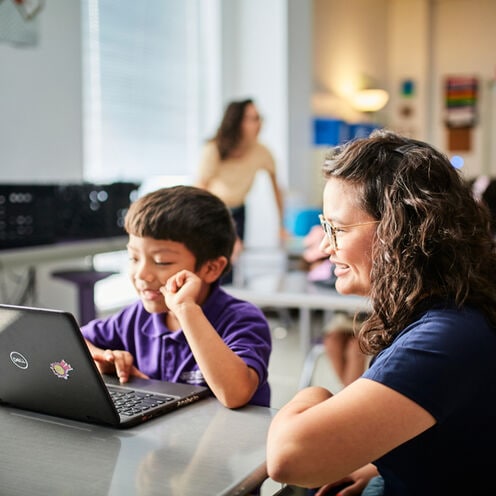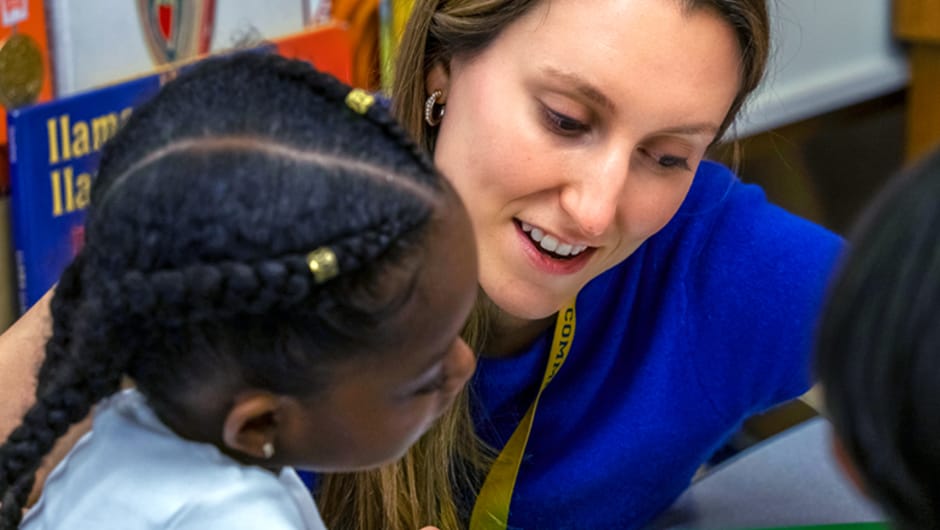
Making Up for Lost Time: Many Schools Turn to Tutoring to Help Reverse Pandemic Learning Disruptions
The coronavirus pandemic disrupted student learning for over two years. But experts say high-dosage tutoring is helping students most impacted by the pandemic to make up for that lost instructional time.
As a certified reading specialist and master teacher, Lauren May (South Louisiana ’08) knows how critical it is for students to learn foundational literacy skills by third grade.
That milestone is considered a pivotal point when students shift from learning to read to reading to learn. But for millions of the nation’s youngest learners, the coronavirus pandemic disrupted this crucial period of literacy development.
So May was relieved when her school, Jackson Elementary in Jackson, Louisiana, began partnering with the Ignite Fellowship in 2021 to help accelerate students’ progress in reading after the pandemic. It meant every child in the early grades who needed reading intervention could have daily access to it.
Ignite Fellowship is a Teach For America tutoring program that virtually pairs K-8 students with college students across the country. Each school day, May’s students logged on for a 30-minute small-group tutoring session with a virtual reading tutor from Ignite. They worked on fundamental reading skills, such as blending letter sounds, through educational games and activities. The students worked with the same tutor each week, May said, which allowed them to “build community and belonging” while addressing the instructional content.
Nationwide, many schools are investing in and relying on tutoring to help accelerate student learning after years of pandemic-related setbacks. Many educators are concerned about students’ performance in core content areas of reading and math—particularly students of color and students from low-income communities, who already faced disparities in academic access prior to 2020. National assessment data released in October affirms those fears.
The National Assessment of Educational Progress, or NAEP, indicated significant declines in math and reading scores among fourth and eighth graders since 2020. Nationally, since 2019, the average math score dropped by five points for fourth graders and eight points for eighth graders. Average reading scores fell by three points since 2019.
To reverse and mitigate these declines, many experts are calling for increased investment in tutoring programs—in particular, intensive long-term tutoring programs that have been proven to help make up for lost learning time and help students achieve better outcomes. Having Ignite tutors provide this type of tutoring has been “a slam dunk opportunity” for her school and her students, May said.
Intensive Tutoring Helps Boost Students’ Academic Gains
A large body of evidence points to the effectiveness of tutoring in improving student learning outcomes, said Matthew Kraft, an associate professor of education and economics at Brown University and leading expert on tutoring research.
“Across almost 100 different randomized controlled trials of a range of different tutoring programs across grades and subjects, tutoring has improved student achievement by a considerable degree,” he said.
One 2020 meta-analysis by the Poverty Action Lab found that “tutoring programs consistently lead to large improvements in learning outcomes for students.” In March, the Brookings Institution analyzed research on the efficacy of different evidence-based interventions such as tutoring, summer learning programs, reduced class size, and extending the school day. Among those interventions, Brookings found that tutoring programs were more effective than the others in increasing math and reading achievement.
While tutoring programs in general have been shown to help students improve academically, Kraft said it is high-impact or high-dosage tutoring that has shown the most significant promise as an intervention.
That approach involves small group or one-on-one tutoring sessions that occur at least three times a week over the span of multiple weeks or months. Students work with the same tutor across all sessions, and the tutoring is integrated into the school day. It is one of the only school-based interventions that demonstrated large positive results on math and reading achievement.
“Part of the motivation for integrating tutoring into the school day is to have it be equally accessible for all students,” Kraft said. He noted that students of color and students from low-income backgrounds have historically lacked access to costly private tutoring. Even after-school tutoring programs can have barriers to access such as transportation costs or competing with children’s family responsibilities.
Other educational leaders have expressed their support for high-dosage tutoring in the aftermath of the pandemic. In a January speech, Education Secretary Miguel Cardona called for school districts to aim to give “every child that fell behind during the pandemic at least 30 minutes per day, three days a week, with a well-trained tutor who is providing that child with consistent, intensive support.”
Now, schools and districts across the country are investing in high-dosage tutoring programs to address pandemic-related learning disruptions. Early data shows the promise of that trend.
Saga Education, a high-dosage tutoring program founded in 2014, reported that its students recovered up to 2.5 years of math in a single academic year and their failure rate in math classes dropped by as much as 63 percent. OnYourMark, a tutoring program founded by Mindy Sjoblom (Baltimore ’00), helped accelerate students’ reading growth by increasing their time spent reading by an average of 1,600 minutes, or more than 26 hours, per student this school year.
At Jackson Elementary, Ignite found that 77 percent of students who participated in the tutoring program met their growth goals as measured by DIBELS, a K-8 literacy assessment, in one semester. In a similar partnership between Ignite and Whittier Middle School in San Antonio, Texas, 84 percent of the participating sixth, seventh, and eighth graders met their math growth goals.
Ignite was founded in 2020 by Teach For America Phoenix with the mission of accelerating learning and fostering belonging with students. In the 2021-2022 school year, 99 percent of schools that partnered with Ignite reported that students grew in academic learning and engagement. This year, Ignite has expanded to 21 communities across the country, partners with 74 schools and supports more than 4,500 students.
Get more articles like this delivered to your inbox.
The monthly ‘One Day Today’ newsletter features our top stories, delivered straight to your in-box.
Content is loading...
Supporting Students and Developing a Pipeline of Educators
The potential benefits of tutoring programs are not just limited to academic growth.
Intensive tutoring could also forge bonds between tutors and their students as they work together over a long period of time, Kraft said. Tutors can become mentors who provide guidance on things such as navigating higher education.
Tutoring programs can also help develop a pipeline of educators, which is needed amid acute teacher shortages in some areas, Kraft said. These programs offer a chance for college students interested in education to gain classroom experience, which can make them more likely to pursue education as a career.
Nia Culpepper, a junior at North Carolina A&T State University, became an inaugural Ignite fellow because she was interested in an education career. She has virtually tutored middle school students in San Antonio and Oklahoma for the past two years.
One of her students struggled with two-digit by two-digit multiplication, and Culpepper worked with him until he felt more confident with the material. Then he eagerly participated in the tutoring sessions, she said. That “was very exciting for me because I felt like I, you know, actually taught this kid.”
Her experiences tutoring for Ignite have reinforced Culpepper’s dream of becoming a teacher through Teach For America.
Interested in Joining Teach For America?
The Potential of Tutoring Beyond the Pandemic
Some states had robust tutoring programs even before the pandemic. The Minnesota Reading Corps, founded in partnership with AmeriCorps in 2003, reports that 80 percent of students who participated in the program achieved more than a year’s worth of progress in one year’s time. Other states opted to use the American Rescue Plan’s $122 billion in Elementary and Secondary School Emergency Relief funds to launch their own tutoring programs: the Chicago Public Schools Tutor Corps, the Arkansas Tutoring Corps, and Tennessee’s TN ALL Corps are just a few examples.
The calls for increased investment in these high-impact tutoring programs have only grown as more assessments bear out the pandemic’s harmful impacts on student learning. In July, the Biden administration urged more schools and districts to invest in high-quality tutoring programs, calling for additional 250,000 mentors and tutors over the next three years to help students make up for lost instruction time.
Providing high-dosage tutoring to every single public school student would be a costly endeavor: roughly $50 billion a year, according to research by Kraft and Grace T. Falken, his colleague at Brown University. Still, Kraft said, the evidence of tutoring’s efficacy in addressing learning disruptions is cause for “serious consideration of investing resources.”
“Success will come over time if we have a relentless commitment to improvement. ”
But he warned that it will take time to see the full potential of intensive, long-term tutoring at scale. He also said it’s important to consider the true goal of tutoring: Is it for academic improvement, increasing attendance and graduation rates, or creating a healthier school climate where students feel like they belong?
“The answer need not be one or the other,” Kraft said. “It can be all of the above, but we should think about what those outcomes are.”
“Success will come over time if we have a relentless commitment to improvement,” Kraft added. “If we abandon it at the sign of the first underwhelming results, I think we'll lose the opportunity that the pandemic has created to kind of rethink how we deliver instruction in public education in the United States.”
For May, the master teacher at Jackson Elementary, even the early outcomes of one year of Ignite’s reading tutoring merit excitement. Students are not just performing better in reading, many also seem more excited about learning.
“They're a really strong group now,” May said about her second grade class.
The program also shows significant promise for the school’s youngest students, she said. “Our focus on literacy in lower grades means that our kindergartners are coming into first grade mostly on level. If that's a trend that can continue and that's a trend that Ignite is supporting, then I think it's going to make a huge, huge difference.”
Sign up to receive articles like this in your inbox!
Thanks for signing up!
Content is loading...





